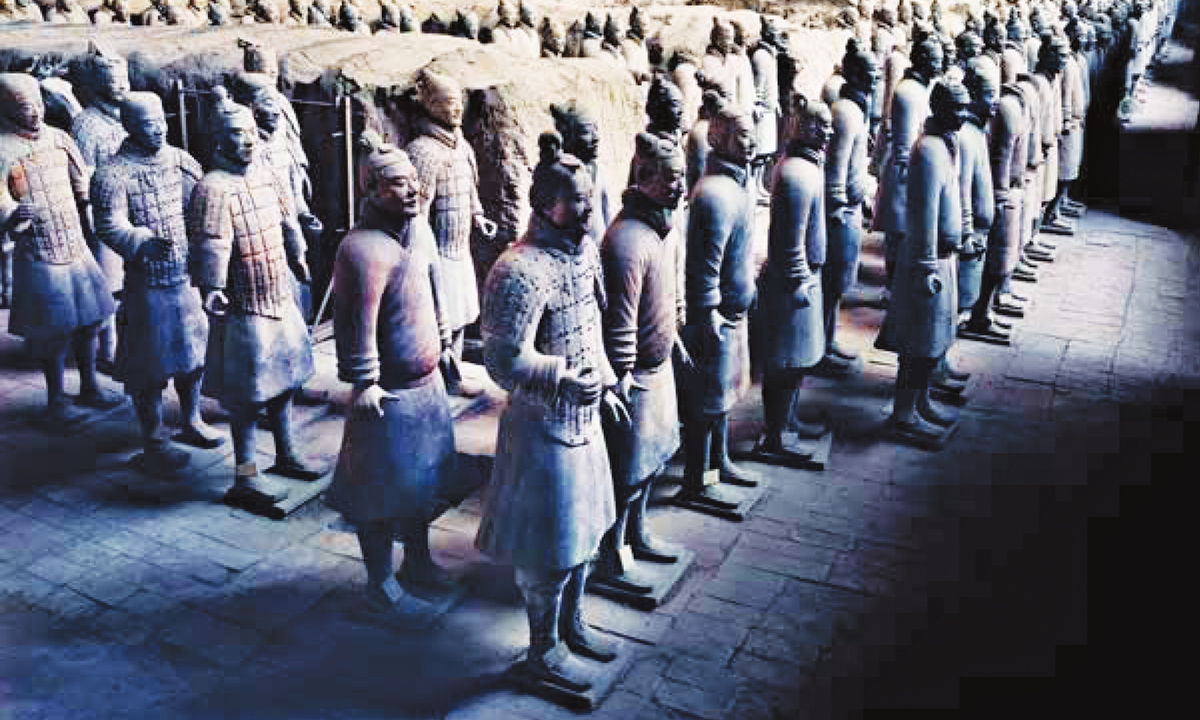Chinese Cultural Relics
Li Li
Terracotta Army Guarding Emperor Qinshihuang's Tomb
One day in 1974, a farmer happened to dig into a burial pit near Emperor Qinshihuang's tomb somewhere at Yanzhai township, Lintong county near Xi'an, capital city of Shaanxi Province. At a depth of about two meters, the farmer found a layer of red earth obviously having been baked in fire and, as he dug deeper, some pottery fragments and bronze weapons were unearthed. The farmer immediately stopped working, and reported what had happened to the proper authorities. Not long afterwards, large-scale excavation began in the area.
Four burial pits were found, including one abandoned before its building was completed. The other three are underground structures of timber and earth. The No 1 pit, with an area of 14,000 square meters, is the largest. The No 2 pit, 6,000 square meters large, lies 20 meters to the north of the
No 1 pit, and takes the shape of a carpenter's square. The No 3, in the shape of the Chinese character 凹, is the smallest. Altogether, more than 7,000 terracotta figures have been found in the pits along with 1,000 terracotta horses. Excavation of the site has been going on since 1974, bringing into daylight more and more relics.
The world was stunned by discovery of this huge terracotta army guarding the tomb of China's first emperor - one of the greatest wonders of ancient civilization. The site is a part of the Guanzhong Plain, the heartland of the northwest China Loess Highlands, where the earth, with pure, fine grains, is good for sculpturing. Painted pottery of the Yangshao Culture, the most outstanding representative of China's matriarchal civilization during its peak that dates to 5000 BC, is originated from the area.
About the book
Chinese Cultural Relics Written by Li Li Published by China Intercontinental Press

Li Li
Terracotta Army Guarding Emperor Qinshihuang's Tomb
One day in 1974, a farmer happened to dig into a burial pit near Emperor Qinshihuang's tomb somewhere at Yanzhai township, Lintong county near Xi'an, capital city of Shaanxi Province. At a depth of about two meters, the farmer found a layer of red earth obviously having been baked in fire and, as he dug deeper, some pottery fragments and bronze weapons were unearthed. The farmer immediately stopped working, and reported what had happened to the proper authorities. Not long afterwards, large-scale excavation began in the area.
Four burial pits were found, including one abandoned before its building was completed. The other three are underground structures of timber and earth. The No 1 pit, with an area of 14,000 square meters, is the largest. The No 2 pit, 6,000 square meters large, lies 20 meters to the north of the
No 1 pit, and takes the shape of a carpenter's square. The No 3, in the shape of the Chinese character 凹, is the smallest. Altogether, more than 7,000 terracotta figures have been found in the pits along with 1,000 terracotta horses. Excavation of the site has been going on since 1974, bringing into daylight more and more relics.
The world was stunned by discovery of this huge terracotta army guarding the tomb of China's first emperor - one of the greatest wonders of ancient civilization. The site is a part of the Guanzhong Plain, the heartland of the northwest China Loess Highlands, where the earth, with pure, fine grains, is good for sculpturing. Painted pottery of the Yangshao Culture, the most outstanding representative of China's matriarchal civilization during its peak that dates to 5000 BC, is originated from the area.
About the book
Chinese Cultural Relics Written by Li Li Published by China Intercontinental Press

Some 1,000 terracotta warriors, horses and chariots have been unearthed from Pit No 1. Photo: Courtesy of the China Intercontinental Press

